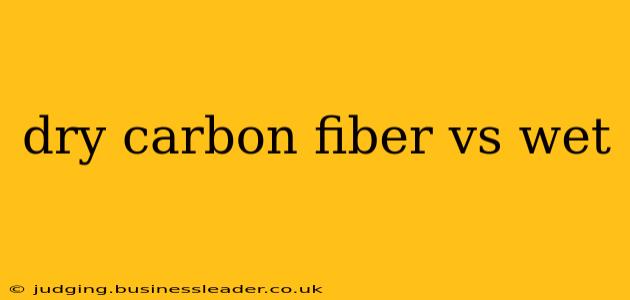Carbon fiber is a remarkable material known for its exceptional strength-to-weight ratio, making it a favorite in high-performance applications like aerospace, automotive, and sporting goods. However, there are two primary methods of manufacturing carbon fiber composites: dry and wet layup. Understanding the differences between these processes is crucial for choosing the right material for your specific needs. This comprehensive guide will delve into the intricacies of dry versus wet carbon fiber, addressing common questions and highlighting the key advantages and disadvantages of each.
What is Dry Carbon Fiber?
Dry carbon fiber uses pre-preg (pre-impregnated) carbon fiber sheets that are already saturated with resin. These sheets are carefully layered and then cured in an autoclave under precise temperature and pressure conditions. The "dry" refers to the low resin content in the pre-preg material compared to wet layup. This precise control over resin content allows for a more consistent and predictable final product.
Advantages of Dry Carbon Fiber:
- Higher Strength-to-Weight Ratio: Due to the lower resin content, dry carbon fiber composites generally exhibit a higher strength-to-weight ratio than wet layup. This is because resin adds weight without proportionally increasing strength.
- Improved Mechanical Properties: The controlled curing process in an autoclave results in a more uniform distribution of fibers and resin, leading to superior mechanical properties like tensile strength, flexural strength, and impact resistance.
- Greater Precision and Consistency: The pre-preg process allows for precise control over fiber orientation and resin content, resulting in a more consistent and predictable final product. This is crucial for applications requiring high dimensional accuracy.
- Better Surface Finish: Dry carbon fiber often exhibits a superior surface finish, reducing the need for extensive post-processing.
Disadvantages of Dry Carbon Fiber:
- Higher Cost: The pre-preg materials and specialized equipment required for autoclave curing make dry carbon fiber significantly more expensive than wet layup.
- More Complex Manufacturing Process: The process is more technically demanding, requiring skilled labor and specialized equipment.
- Less Flexibility in Design: While offering excellent precision, the pre-preg nature limits the flexibility in design changes compared to wet layup.
What is Wet Carbon Fiber?
Wet carbon fiber involves manually laying up dry carbon fiber fabric or tow into a mold and then saturating it with resin on-site. This method is simpler and less expensive than dry layup.
Advantages of Wet Carbon Fiber:
- Lower Cost: The simpler process and less specialized equipment make wet carbon fiber significantly cheaper than dry layup.
- Greater Design Flexibility: Wet layup offers greater flexibility for complex shapes and designs, allowing for greater creativity in design.
- Simpler Manufacturing Process: The process is less technically demanding, requiring less specialized equipment and training.
Disadvantages of Wet Carbon Fiber:
- Lower Strength-to-Weight Ratio: The higher resin content typically results in a lower strength-to-weight ratio compared to dry layup.
- Inconsistent Quality: Manual layup can lead to inconsistencies in fiber orientation and resin content, affecting the final product's mechanical properties.
- Poorer Surface Finish: Wet layup often requires more post-processing to achieve a desirable surface finish.
- Higher Void Content: Manual impregnation can lead to higher void content (air pockets within the composite), reducing strength.
Which is Better: Dry or Wet Carbon Fiber?
The choice between dry and wet carbon fiber depends heavily on the specific application and priorities. Dry carbon fiber is ideal for high-performance applications where strength-to-weight ratio, precision, and consistency are paramount, even at a higher cost. Wet carbon fiber is a more cost-effective option suitable for applications where high precision and strength aren't as critical, such as prototyping or less demanding parts.
Is Dry Carbon Fiber Stronger Than Wet Carbon Fiber?
Generally, yes, dry carbon fiber is stronger than wet carbon fiber due to the lower resin content and more controlled curing process. This leads to a higher fiber volume fraction and improved mechanical properties. However, the exact strength difference can vary depending on the specific materials, layup techniques, and curing parameters used.
What are the Applications of Dry and Wet Carbon Fiber?
Dry Carbon Fiber: Aerospace components, high-performance automotive parts (e.g., Formula 1 cars), bicycle frames, high-end sporting goods.
Wet Carbon Fiber: Prototypes, less demanding automotive parts, marine applications, hobbyist projects, some sporting goods.
What is the Difference in the Manufacturing Process?
The key difference lies in the pre-impregnation of the carbon fiber. Dry carbon fiber uses pre-preg sheets, while wet carbon fiber involves manually impregnating the dry fibers with resin on-site. Dry carbon fiber requires an autoclave for curing, while wet carbon fiber can be cured in ovens or at room temperature, though with longer curing times.
This detailed comparison should provide a clearer understanding of the differences between dry and wet carbon fiber, enabling you to make informed decisions based on your specific requirements. Remember to always consult with experts for complex applications requiring precise material selection.
